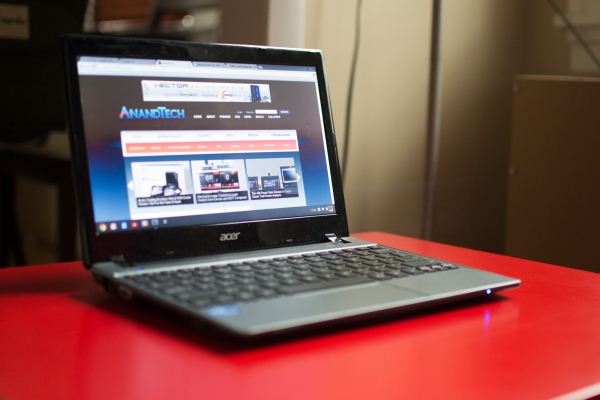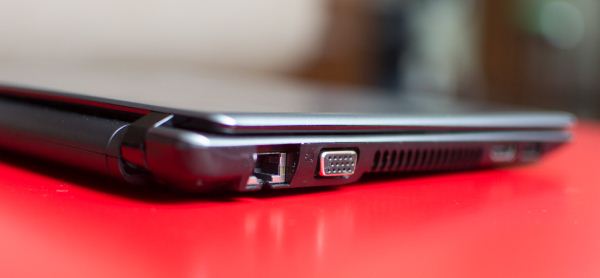Acer C7 Chromebook Review
by Jason Inofuentes on January 21, 2013 12:30 PM ESTIf today we were reviewing the Acer Aspire One A0756-2641 notebook, from which the Acer C7 Chromebook is derived, then it would be really brief. Compromised, and too expensive. Priced at around $329, the spec sheet is spared utter embarrassment by having a low-end Sandy Bridge processor, rather than something from the Atom line. Aside from that, it’s hard to argue in favor of this notebook when a little more cash can net you a small caching SSD, more RAM, a better processor and a goodly performance boost. But this isn’t the Acer Aspire One. This is the Acer C7 Chromebook, and it only costs $199. Does that make all the difference? Let’s take a look.
In consumer electronics, every market segment goes through this moment when the technology becomes affordable enough that it becomes a race to the bottom. The netbook movement pulled the floor out from under notebook prices, and the results were, at first, severely compromised and almost unbearable. The long term result of the ensuing price pressure means a fantastic Windows laptop can be had for well under $1000. Much of this is owed Intel’s fabs (and marketing) and we are in an era of high IPC, power efficient and cheap x86 processors powering notebooks of all shapes and sizes.
The full promise of the netbook was never truly acheived, though. There are no “good enough” Windows notebooks available for under that magic $200 barrier. Today’s Atom lacks the oomph to make the user experience one we’d recommend. Move up to a more modern Intel CPU, though, and you get a better experience, but a higher price. So what happens if you take the aforementioned Acer Aspire One A0756-2641 (a Windows 8 notebook with an 11.6” screen and a Sandy Bridge-based Celeron processor with Intel HD Graphics and a 320GB HDD and 2GB of RAM) but stripped out that Windows license and charged $199 for it?
Let’s talk turkey. Thin, flexible plastic does not inspire confidence, nor does it feel good against your finger tips. That’s something we’ve known for a while, long before the materials experienced a resurgence as the netbook movement really grew its wings and become the benchmark for cheap notebooks. You can make the millimeter thin composites look good, and you can even give it an internal structure that is rigid, but it will always feel cheap.
The Acer C7’s design isn’t terrible. As a color-blind person, I really am much more comfortable around grey-tone products, I never have to worry that I’m secretly wearing purple pants. What kills me is a poor tactile experience. So I was surprised to discover that the cheap plastic forms a pretty solid feeling device. When you hold the chassis in one hand, opened, you can feel the plastic body flexing in your hand, but there’s still enough rigidity that you might be convinced it could survive a short fall. The display’s hinges are solid with no jiggle or dead space, and can be laid nearly flat.
The keyboard is narrower than the best of them, but isn’t so cramped that typing becomes a chore. Proper QWERTY alpha/numeric key placement is a must for me, and here the C7 acquits itself well. The keys themselves are well sprung, if a little shallow, and provide good feedback that they’ve been sufficiently depressed. The directional keys are a bit minuscule, and that can be frustrating, particularly given that you may use them more than the trackpad for making selections.
The touchpad is wider than I expected, and fills nearly the full distance from the keyboard to the edge of the device, but is sadly made of the same cheap plastic as the rest of the body. The result is that, though the body feels solid and the mechanical components are sufficient, there’s just nothing particularly pleasing to touch. The touchpad’s performance is also a bit lacking. Two finger scrolling works well enough, but pinch to zoom was hit or miss and not supporting additional gestures makes it almost impossible to accurately select text or drag a file. For accuracy’s sake I prefer the directional keys, their size not withstanding.
While the base of the C7 tapers down towards the user, the display body is a uniform depth and a bit thicker than I might have hoped. Despite its thickness, with just a mild bit of force you can flex the display pretty radically; not a confidence inspiring trait. Bezels aren’t too radical, and the camera is centered within the top bezels, with the Acer logo below the display.
With the base tapering to a slim edge, the bulk of the laptops weight is in the battery towards the back of the device. Along the bottom of the C7 are myriad vents and labels, and a pair of speaker grills. A single screw beneath a warranty sticker restricts the removal of the bottom panel; and our review sample just happened to be missing that screw entirely. With no screw in the way it’s quite easy to slide the panel off and have access to the hard drive, RAM and wireless module, along with a close look at the cooling mechanism. The left side houses the ethernet and VGA ports on one side of a rather large vent, and HDMI and USB 2.0 on the other. The right side sports the Kensington lock port, power, 2xUSB 2.0 and headset port. Along the front edge are power and charging indicator LEDs, and a sprung SD slot with a molded blank to fill it when the slot isn’t being used.
The C7’s two speakers sit on the beveled edge of the C7, below the wrist rest. Their output won’t rattle your windows, and might not be enough to hear clearly from across the room, but they’ll do from arm’s length.





















63 Comments
View All Comments
JasonInofuentes - Tuesday, January 22, 2013 - link
In the terminal I was able to run cat /proc/cpuinfo during lots of scenarios and the output was always 800MHz. Since there's no way to run monitoring programs in a Chrome OS instance, and since the clock and voltage tables aren't exposed as they were in the Samsung Chromebook, we don't know whether this is an intermediate state, but based on the results I'm confident of that figure as the max clock.Exophase - Tuesday, January 22, 2013 - link
Are you sure it said 800MHz for both cores? Can you test it while running a workload you know is pegging the CPU indefinitely, preferably a backgrounded command line task like dd?Frankly I think the scores don't really add up for 800MHz. Look at what the lower end Samsung Chromebox achieves here:
http://www.tomshardware.com/reviews/chromebox-chro...
That uses a Celeron B840 which is clocked at 1.9GHz, and since it isn't running on a battery they'd have no reason to underclock it. If you scale its Sunspider score of 296ms from 1.9GHz to 1.1GHz you get 511ms, which fits perfectly with the values you got in this review. At 800MHz you would expect a number closer to 700ms. This is assuming linear scaling, but given Sunspider is single threaded and these are fairly low clocks for both I doubt you'd get much worse. I also doubt that V8 made huge improvements in its x86 performance since then.
sonnyrao - Sunday, January 27, 2013 - link
Hi, it is definitely a 1.1Ghz processor, but has cpu frequency scaling enabled like any other modern system. I'm not sure what scenarios you ran but looking at /proc/cpuinfo isn't really the best way to determine frequency. At the minmum, you should be looking at /sys/devices/system/cpu/cpu*/cpufreq/scaling_cur_freqbut running something like powertop or i7z would be even better (you can copy them onto the C7 from another 32-bit Linux system)
I'd do something like this, put it into dev mode, open a window for crosh (ctrl-alt-t) and run the shell from there sudo to become root
then run
watch -d cat /sys/devices/system/cpu*/cpufreq/scaling_cur_freq
and then run your benchmarks in another window.
jabber - Tuesday, January 22, 2013 - link
I've been trying out Lenovo Q180 Nettops recently. The ones I've been rolling out have the top end 2.1Ghz Atom in them, with 4GB of ram and a HD6450 GPU in them.Tally this together with a Sandisk Extreme 120GB SSD and the computing experience is pretty good. In all the usual computing tasks I couldn't tell it was an Atom based machine. It felt as fast and fluid as any full size x86 PC I have around. I've rolled a few of them out to small businesses and feedback has been excellent.
The problem with Atom is that makers feel they have an excuse to pair them up with even crappier hardware. Throw in an Atom chip with some decent supporting hardware and you have a pretty good low power setup.
lmcd - Saturday, January 26, 2013 - link
The graphics tied with Atom are probably the most hindering aspect.max347 - Tuesday, January 22, 2013 - link
Great review!I think the pics could use a little less bokeh though :-)
nathanddrews - Tuesday, January 22, 2013 - link
LOL - first thing I thought of. DOF is cool, but not if you can't even tell what's on the IO panel.JasonInofuentes - Wednesday, January 23, 2013 - link
Fair enough, I'm trying to get a nice light set-up that would facilitate more bokeh-free shots, but in the meanwhile I'm generally just trying to keep people from seeing the mess my house is generally in. :) Thanks for the compliment.Jason
Notmyusualid - Wednesday, January 23, 2013 - link
And it was so dog dam slow, that I GAVE IT AWAY, as soon as I got back from my deployment in the USA.Really, it gave me chest pains waiting for it to do anything.
I tried upgrading the RAM, and that made very little difference.
I realised quickly that I was wasting my time.
The 10yr old niece was happy to receive it though....
dj christian - Thursday, January 24, 2013 - link
Justin where did Anand cover the Chrome OS? It would be nice if you could provide us with a link to it.Thanks!